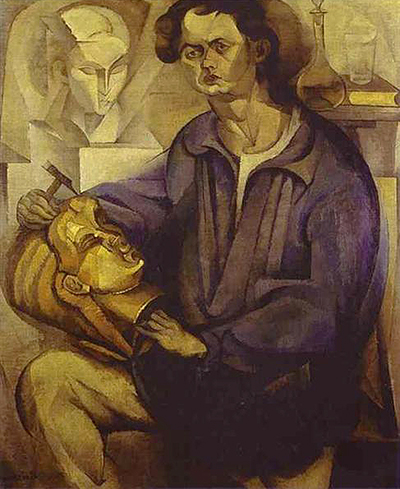Portrait of Oscar Miestchaninoff is a painting by Diego Rivera from 1913 and is categorised within the Cubist style. The artist tried out many different artistic methods whilst living and working in Europe and travelled around in search of new inspiration.
Within more traditional periods of art history it was common to place a portrait figure alongside clues which would help to tell the viewer more about their life. Frequently this would include details about their occupation and Rivera continues that technique here with this portrait of Oscar Miestchaninoff. He is pictured looking directly at us with a serious expression, whilst holding a sculptured head in his head. As he perches it on his right leg, he also holds a chisel in his other hand, setting the scene as if he was busy at work and just interrupted by the painter. He is dressed in a fairly shapeless outfit which could easily be overalls which sculptors would wear in order to avoid dust particles being trapped in their normal clothes. Behind him we find further examples of his work within this cramped composition in which Rivera puts as much detail as possible. Despite this painting's use of Cubism, this portrait is relatively easy to understand and identify its different elements.
Oscar Miestchaninoff was a famous Belarusian sculptor who moved over to France in order to make the most of his creative talents. It is there that he would have come across Rivera, and we also know that Amedeo Modigliani, a friend of Rivera's, would also produce a portrait of Miestchaninoff at around the same time. Paris was a real melting pot of different ideas in the early 20th century and many creatives from around the globe chose to move here in order to seek out as many new ideas as they could, as well as to build a strong reputation of their own within this culturally rich metropolis. Miestchaninoff was also an expert in the arts of Ancient Asia and exhibited across France and further afield in Europe.
This portrait is sized at 147 cm x 120 cm and can now be found within the collection of the Pinacoteca Diego Rivera in Veracruz, Mexico. The artist completed a large number of Cubist paintings in around this period, directly influenced by a number of European painters who were doing exactly the same. Most would then move on to other challenges soon after but some chose to specialise within this approach for the rest of their careers. Rivera was always unable to stick to one style for long, mainly due to his curiosity as an artist, and so inevitably would seek out new ideas fairly soon after this piece elsewhere in Europe. He was keen to understand and appreciate as much about European culture as he could before he would inevitably return to his native Mexico. He was one of very few artists to have successfully married the best of European and Mexican art together at various points in his career.




